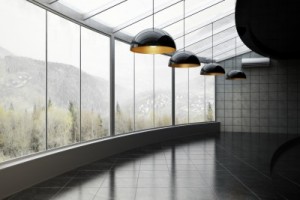Post-traumatic stress disorder is a legacy of war that haunts many veterans for years or decades after their service ends. It makes normal living painfully difficult for many. Some architects are taking notice.
The new veterans legal clinic at John Marshall Law School in Chicago is a prime example. The clinic, designed by architect Chad Harrell of the firm Griskelis Young Harrell, is loaded with features designed to put PTSD sufferers at ease.
For example, the hallways are wide, allowing visitors to envision a rapid exit. Big windows provide lots of comforting natural light, and soothing light green paint and wood furniture put the clinic’s patrons at ease. Heavy acoustic insulation keeps out traffic noise, and frosted glass panels instead of walls create the sense of open spaces, yet preserve privacy.

PTSD Designed Office Interior
“When we design using PTSD as a filter, you can see the areas that you have to alter because they might create a sense of discomfort and stress,” said Harrell in an interview published in the Chicago Tribune.
This is evidently the first law clinic built with PTSD sufferers in mind, but some medical facilities have been built that way. An outpatient mental health clinic designed by Christner Architects includes lots of natural daylight, stress-reducing colors and materials, and seating that prevents veterans from feeling they are “out in the open.” Read more here.
AIA Chicago held a symposium on the topic in 2010. Among issues discussed at the symposium included the importance of calming community spaces for PTSD sufferers. Click here for some info on the symposium.
Landscape architects also can keep PTSD issues in mind. Jesse Hartman, a graduate student in landscape architecture at Ohio State University, prepared a thesis on the role landscape architecture can play regarding PTSD.
As with building architecture, PTSD-mindful landscape architecture should be soothing and free from elements that may stimulate the “fight or flight” instinct. For example, Hartman notes that a palm grove can be stress inducing for a veteran with PTSD:
“[A] Palm Grove is made up of vertical columns, a high dense canopy and low scrub plantings. Together these characteristics provide multiple places for threats to hide, obscure clear sightlines, and overall, they are disorienting,” he writes.
You can read his entire thesis here.
Serving veterans who suffer from PTSD will be an important concept for architects for decades to come.

